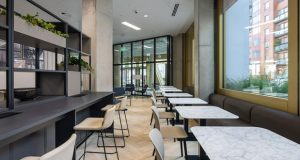 Julian Sheldrake, Director of Q Office Furniture, advises on how to put employees’ health and wellbeing at the forefront of office design
Julian Sheldrake, Director of Q Office Furniture, advises on how to put employees’ health and wellbeing at the forefront of office design
One of the hottest trends in office furniture, particularly in offices with a hot-desking policy, is for sit-stand desks. These are always the first to be snapped up by the early birds, or booked in offices with a reservation policy. Larger offices have also seen the introduction of standing-only desks, which have proved popular with those who have a history of back problems.
Most of us, however, are unlikely to stand at our desk all day and probably work in a more traditional office environment. In fact, the average UK worker spends nine hours sitting down every day. As a result, choosing the right seat is vital.
The first thing to note is that not all seats are the same. Most seats, for example, have some padding, but this varies greatly in depth and quality. Choosing a chair with the right seat depth can make an amazing difference for those experiencing pain or preventing it in the first place. Equally, choosing a chair that supports the natural curve of the spine, together with the head and neck, will make a significant difference to how employees feel at the end of the day.
A recent report by the British Chiropractic Association (BCA) showed that over a third of British workers have taken a day off work due to back or neck pain in the last 12 months. Furthermore, this pain resulted in an average absence of 12 days. Less than a quarter of those interviewed had been offered advice on how to sit at their desks correctly to prevent work-related back pain, and only a fifth had been offered a desk assessment, ergonomic chairs, laptop stands or monitor arms.
Many tweaks can be made to help reduce the likelihood of employees experiencing work-related back pain. One of the most obvious is to ensure that people have a working environment suited to their individual needs. A recent study undertaken at the University of Loughborough and published in the British Medical Journal found that giving employees height-adjustable desks resulted in reduced levels of anxiety, fatigue and back pain, as well as making them feel more productive and engaged.
ACOUSTIC BOOTHS
For the last 30 years there has been a trend towards open-plan office layouts (also known as ‘collaborative space’). However, the value of this change is starting to be questioned. Does it really enhance performance, or does it contribute to more distraction than genuine discussion? Recent studies have suggested the effect on workers’ concentration could ultimately be impacting on productivity, so it will be interesting to see if the pendulum swings back.
One recent innovation designed to alleviate some of these issues is acoustic booths, for use within collaborative working areas. Acoustic booths come in two forms: privacy booths for those working solo, and booths for small groups which can be made in all different shapes and sizes, semi- or fully enclosed. These nifty, portable pods are on castors and can be moved around as and when needed. They also offer a cheaper and more flexible alternative to traditional, fixed meeting rooms.
Be mindful, however, that booths vary enormously in quality and price. You get what you pay for, and this is reflected in the level of built-in technology in the acoustic panels. The whole point of these booths is that you can’t hear what’s going on inside them – both from a confidentiality and concentration perspective. Tessellate acoustic panels are a stylish option, available in hundreds of colours, shapes and sizes. As well as providing privacy and reducing low-level noise, they can add vibrancy and colour to the workplace. There is also the opportunity to incorporate videoconferencing facilities in a space where it was previously impossible due to background noise.
GREEN OFFICES
Among the trends trickling down from high-end City offices to the mass market are so-called living walls. Biophilia, meaning love of nature, focuses on our innate attraction to nature and natural processes. Living walls are both beautiful to look at and contribute to feelings of energy and alertness by removing carbon dioxide from the air.
Businesses regarded to be at the cutting edge of workplace design, such as Apple, Google and Amazon, are investing heavily in biophilic design elements. The presence of natural features not only improves worker concentration, engagement and cognitive ability, but helps to attract and retain staff in the ongoing war for talent.
Research has shown that incorporating direct or indirect elements of nature into the built environment reduces stress, blood pressure levels and heart rates, while increasing productivity by up to eight per cent. It also aids creativity, boosts self-reported rates of wellbeing by up to 13 per cent, and reduces absenteeism.
Biophilic design can be implemented according to budget – it doesn’t have to mean spending thousands on a carefully curated living wall. Simply investing in some attractive but low-maintenance pot plants will enhance your office environment.
Lighting is another factor known to have a significant impact on workers’ physical and mental wellbeing. This goes beyond the functional and safety aspects of providing enough illumination to see by; lighting can affect mood and circadian rhythms (also known as sleeping patterns), while poor lighting can cause glare, headaches, eyestrain, and aches and pains associated with poor body posture.
LED lighting has seen a huge surge in popularity in the past 10 years. LEDs offer certain health benefits compared with other lighting sources as they do not contain mercury, have lower human toxicity potential and emit little or no UV. Recent increases in the luminous efficacy of LEDs have led to similar or even better energy efficiency compared with conventional lighting products. The long lifetime of LEDs offers additional benefits by reducing maintenance costs and minimising disruption associated with relamping in continuously occupied areas.




